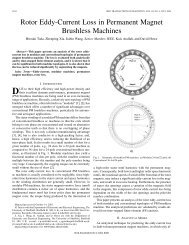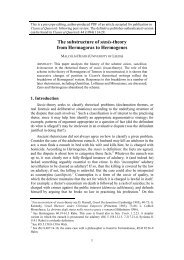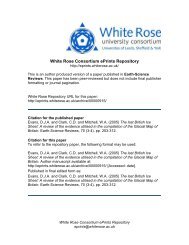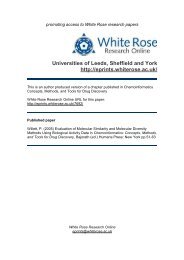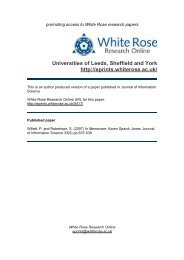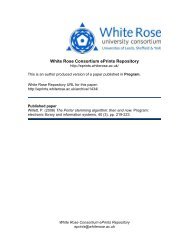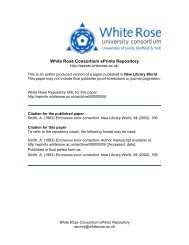The archaeological context of the Iwo Eleru cranium from Nigeria ...
The archaeological context of the Iwo Eleru cranium from Nigeria ...
The archaeological context of the Iwo Eleru cranium from Nigeria ...
Create successful ePaper yourself
Turn your PDF publications into a flip-book with our unique Google optimized e-Paper software.
West AfricAn ArchAeology: neW developments, neW perspectives<br />
put forward, Shaw divided <strong>the</strong> LSA into two successive<br />
phases, aceramic and ceramic, each <strong>of</strong> which was<br />
characterised by a number <strong>of</strong> facies. In <strong>the</strong> aceramic<br />
phase, <strong>the</strong>re were essentially two facies only, microlithic<br />
and non-microlithic (represented on <strong>the</strong> map by open □s<br />
and Δs) and <strong>the</strong>se were equated with savanna and forested<br />
environments respectively. In <strong>the</strong> succeeding phase, <strong>the</strong><br />
same distinction was observed between savanna and forest<br />
(<strong>the</strong> sites being represented on <strong>the</strong> map by filled squares<br />
and triangles). In both, pottery and ground stone axes<br />
made <strong>the</strong>ir appearance, but in <strong>the</strong> savanna <strong>the</strong>se elements<br />
were added to <strong>the</strong> microlithic base whereas in <strong>the</strong> forest<br />
<strong>the</strong>re were still few or no microliths. In <strong>the</strong> former case, as<br />
Shaw put it, pottery and ground stone axes appeared to be<br />
“grafted onto <strong>the</strong> microlithic tradition ra<strong>the</strong>r than to replace<br />
it” (Shaw, 1978/79: 61). Both phases were represented in<br />
superposition at some sites in both environments. In <strong>the</strong><br />
forested south-western part <strong>of</strong> <strong>the</strong> region, mention has<br />
already been made <strong>of</strong> Yengema, and this is shown on <strong>the</strong><br />
map as a numbered pair (9:33), as is Kakimbon (8:32),<br />
whereas Blandè (30) is represented by <strong>the</strong> ceramic phase<br />
only. <strong>The</strong> succession at <strong>Iwo</strong> <strong>Eleru</strong> (3:15) is paralleled<br />
among o<strong>the</strong>r places by that at Dutsen Kongba (38:41),<br />
Rop (2:14), Bosumpra (Abetifi), and o<strong>the</strong>r shelters<br />
along <strong>the</strong> Voltaian scarp (47:48 and 24). Bosumpra was<br />
excavated by Shaw in <strong>the</strong> 1940s and originally published<br />
as a ceramic phase site only, but a pre-ceramic phase was<br />
later detected at this location (Smith 1975). Radiocarbon<br />
dates for <strong>the</strong> transition <strong>from</strong> aceramic to ceramic at Dutsen<br />
Kongba and Bosumpra were not inconsistent with those<br />
<strong>from</strong> <strong>Iwo</strong> <strong>Eleru</strong>. Apart <strong>from</strong> <strong>the</strong> two major ceramic<br />
variants, a number <strong>of</strong> sites in <strong>the</strong> Sahel with few or no<br />
microliths were distinguished as a separate facies, as well<br />
as some coastal shell middens and factory sites (Shaw,<br />
1978/79: 67 Table). Shaw was cautious in not claiming<br />
too much for his scheme, since as he said, it was no more<br />
than a “convenient classification <strong>of</strong> artefact groups with<br />
some reference to ecology”, whereas “its interpretation in<br />
cultural, ethnic and linguistic terms” would require more<br />
research before it could be said to have much reliability<br />
(Shaw, 1978/79: 65). None<strong>the</strong>less, <strong>the</strong> scheme did provide<br />
and still provides a useful framework within which to<br />
consider <strong>the</strong> wider significance <strong>of</strong> <strong>Iwo</strong> <strong>Eleru</strong>.<br />
Human skeletal material was mentioned <strong>from</strong><br />
Karkarichinkat, Kourounkorokale, Tichitt, Daima,<br />
Kintampo, and Rop (Shaw, 1978/79: 76) but at <strong>the</strong> time<br />
none <strong>of</strong> this material was dated and was certainly not<br />
considered older than <strong>Iwo</strong> <strong>Eleru</strong>.<br />
Recent developments<br />
Since <strong>the</strong> original report on <strong>Iwo</strong> <strong>Eleru</strong> was published, at<br />
least two hi<strong>the</strong>rto unknown sites with skeletal remains<br />
have been located in <strong>the</strong> region, new information has been<br />
obtained about <strong>the</strong> chronology <strong>of</strong> <strong>the</strong> MSA and <strong>the</strong> LSA in<br />
general, and considerable attention has also been devoted<br />
to <strong>the</strong> study <strong>of</strong> <strong>the</strong> environment during <strong>the</strong> period in<br />
question. <strong>The</strong>se developments will briefly be summarised<br />
ins<strong>of</strong>ar as <strong>the</strong>y are relevant to <strong>Iwo</strong> <strong>Eleru</strong>.<br />
36<br />
Shum Laka and Gobero<br />
<strong>The</strong>se are key sites, nei<strong>the</strong>r <strong>of</strong> which was known when<br />
Shaw published his work on <strong>Iwo</strong> <strong>Eleru</strong>.<br />
Shum Laka is a rock shelter 15 km south-west <strong>of</strong> Bamenda<br />
in western Cameroun (5°51’37” N, 10°04’44” E). At<br />
an altitude <strong>of</strong> 1650 metres above sea level, it is situated<br />
in <strong>the</strong> mountainous region known as <strong>the</strong> Grasslands.<br />
Following initial investigations, an extensive excavation<br />
was undertaken over a six month period in 1991-1994, and<br />
this has provided <strong>the</strong> essential information about <strong>the</strong> site<br />
(Lavachery et al., 1996; Moeyersons, 1997; Lavachery,<br />
2001; Cornelissen, 2003). It has been demonstrated, for<br />
<strong>the</strong> first time in West Africa, that <strong>the</strong> LSA extends back<br />
into <strong>the</strong> Pleistocene. Five radiocarbon dates (<strong>from</strong> layer S)<br />
span <strong>the</strong> period <strong>from</strong> 31,700±750 to 12,800±110 BP. As at<br />
<strong>Iwo</strong> <strong>Eleru</strong>, <strong>the</strong> sequence continues into <strong>the</strong> early Holocene<br />
and beyond (layer A, divided into a lower ochre and an<br />
upper grey coloured unit), extending without much sign<br />
<strong>of</strong> interruption into <strong>the</strong> early iron age. <strong>The</strong> microlithic<br />
industry, made principally in quartz, is very similar to<br />
that <strong>from</strong> <strong>Iwo</strong> <strong>Eleru</strong>, although macrolithic elements which<br />
appear in <strong>the</strong> upper part <strong>of</strong> <strong>the</strong> sequence are distinctive.<br />
Cornelissen and Lavachery question whe<strong>the</strong>r (as in Shaw’s<br />
scheme) microliths should necessarily be considered an<br />
adaptation to savanna conditions, and <strong>the</strong> macrolithic<br />
“culture” characterised by “waisted axes” which appears<br />
later seems to be bounded by frontiers which do not<br />
reflect ecological conditions. As at <strong>Iwo</strong> <strong>Eleru</strong> however<br />
an aceramic phase is succeeded by a ceramic phase, with<br />
<strong>the</strong> earliest pottery in <strong>the</strong> ochre layer A dated to 7140±50<br />
BP. As a result <strong>of</strong> <strong>the</strong>se discoveries, it has been suggested<br />
by MacDonald (1997: 161, 192) that we should think in<br />
terms <strong>of</strong> “a new model for <strong>the</strong> peopling <strong>of</strong> West Africa<br />
based upon a long-term autochthonous presence south <strong>of</strong><br />
<strong>the</strong> Sahara”, which found its material expression in “an<br />
indigenous terminal Pleistocene West African microlithic<br />
techno-complex”.<br />
18 skeletons have been found in <strong>the</strong> Holocene deposits at<br />
<strong>the</strong> site, in 9 burial complexes, which are attributed to two<br />
different chronological phases (Orban et al., 1996; Ribot<br />
et al., 2001). 3 burials with 4 individuals are attributed to<br />
<strong>the</strong> ochre layer A, with dates in <strong>the</strong> range <strong>from</strong> 7150±70 to<br />
6870±80 BP. This layer corresponds <strong>archaeological</strong>ly and<br />
chronologically to period B1 at <strong>Iwo</strong> <strong>Eleru</strong>, and <strong>the</strong> burials<br />
are clearly more recent than <strong>the</strong> one at <strong>Iwo</strong> <strong>Eleru</strong>. Orban<br />
and Ribot and <strong>the</strong>ir colleagues compared <strong>the</strong>se skeletons to<br />
<strong>Iwo</strong> <strong>Eleru</strong> principally on <strong>the</strong> basis <strong>of</strong> postcranial features,<br />
particularly estimated stature (Ribot et al., 2001: table<br />
35), though similarities were also detected in terms <strong>of</strong> a<br />
broad mandibular ramus and very worn teeth (Ribot et al.,<br />
2001: 193). Two adult male burials at Shum Laka have<br />
an estimated stature in <strong>the</strong> range 161-166 cm, compared<br />
with a figure for <strong>Iwo</strong> <strong>Eleru</strong> <strong>of</strong> 158-166 cm. 6 burials are<br />
known <strong>from</strong> <strong>the</strong> grey layer A, which has dates between<br />
3300±90 and 2940±60 BP. Of <strong>the</strong> individuals identified<br />
9 are children and 5 are adults. Chronologically <strong>the</strong> finds<br />
correspond to period B2 at <strong>Iwo</strong> <strong>Eleru</strong>. <strong>The</strong>re are marked




